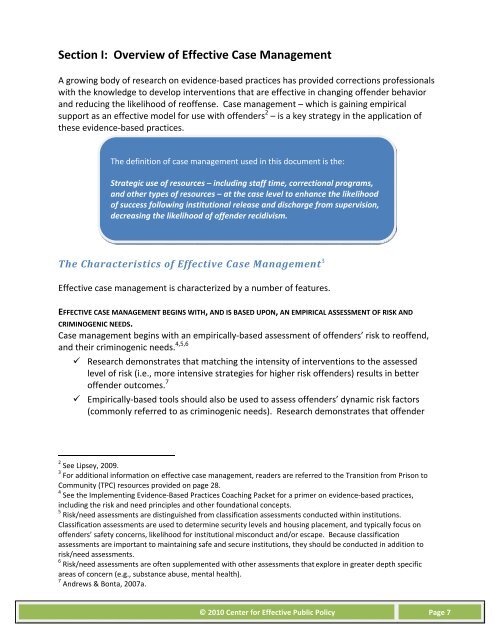COACHING PACKET Effective Case Management - The Center for ...
COACHING PACKET Effective Case Management - The Center for ...
COACHING PACKET Effective Case Management - The Center for ...
You also want an ePaper? Increase the reach of your titles
YUMPU automatically turns print PDFs into web optimized ePapers that Google loves.
Section I: Overview of <strong>Effective</strong> <strong>Case</strong> <strong>Management</strong><br />
A growing body of research on evidence-based practices has provided corrections professionals<br />
with the knowledge to develop interventions that are effective in changing offender behavior<br />
and reducing the likelihood of reoffense. <strong>Case</strong> management – which is gaining empirical<br />
support as an effective model <strong>for</strong> use with offenders 2 – is a key strategy in the application of<br />
these evidence-based practices.<br />
<strong>The</strong> definition of case management used in this document is the:<br />
Strategic use of resources – including staff time, correctional programs,<br />
and other types of resources – at the case level to enhance the likelihood<br />
of success following institutional release and discharge from supervision,<br />
decreasing the likelihood of offender recidivism.<br />
C%+ !%#.#$,+.&/,&$/ "6 766+$,&8+ !#/+ B#'#(+=+', 3<br />
<strong>Effective</strong> case management is characterized by a number of features.<br />
EFFECTIVE CASE MANAGEMENT BEGINS WITH, AND IS BASED UPON, AN EMPIRICAL ASSESSMENT OF RISK AND<br />
CRIMINOGENIC NEEDS.<br />
<strong>Case</strong> management begins with an empirically-based assessment of offenders’ risk to reoffend,<br />
and their criminogenic needs. 4,5,6<br />
ü Research demonstrates that matching the intensity of interventions to the assessed<br />
level of risk (i.e., more intensive strategies <strong>for</strong> higher risk offenders) results in better<br />
offender outcomes. 7<br />
ü Empirically-based tools should also be used to assess offenders’ dynamic risk factors<br />
(commonly referred to as criminogenic needs). Research demonstrates that offender<br />
2 See Lipsey, 2009.<br />
3 For additional in<strong>for</strong>mation on effective case management, readers are referred to the Transition from Prison to<br />
Community (TPC) resources provided on page 28.<br />
4 See the Implementing Evidence-Based Practices Coaching Packet <strong>for</strong> a primer on evidence-based practices,<br />
including the risk and need principles and other foundational concepts.<br />
5 Risk/need assessments are distinguished from classification assessments conducted within institutions.<br />
Classification assessments are used to determine security levels and housing placement, and typically focus on<br />
offenders’ safety concerns, likelihood <strong>for</strong> institutional misconduct and/or escape. Because classification<br />
assessments are important to maintaining safe and secure institutions, they should be conducted in addition to<br />
risk/need assessments.<br />
6 Risk/need assessments are often supplemented with other assessments that explore in greater depth specific<br />
areas of concern (e.g., substance abuse, mental health).<br />
7 Andrews & Bonta, 2007a.<br />
© 2010 <strong>Center</strong> <strong>for</strong> <strong>Effective</strong> Public Policy Page 7


